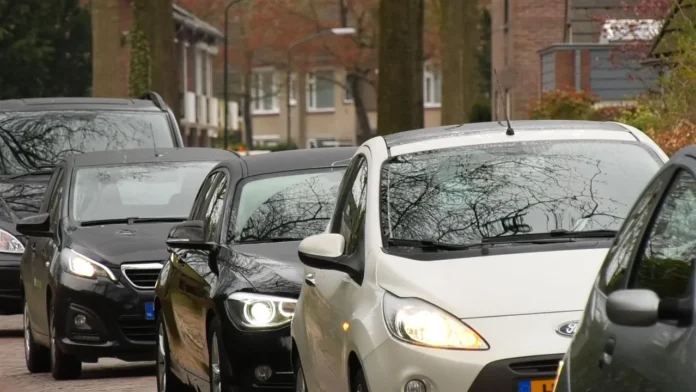Eindhoven by the sea: this might just become reality. So far, Eindhoven has not met even half of its CO2-reduction goals for 2025. Both the speed and scope of the measures need drastic improvement. Studio040 reserch has brought this to light.
The consequences of climate change are becoming more visible and tangible. Last year there were floods in Limburg, Belgium and Germany. This year a large part of the summer was marked by extreme drought, and there were constant forest fires in France, Spain and Portugal. More and more people realise that we have to do our utmost to ensure a habitable environment.
Less than half of the necessary reduction
Yet progress is far too slow. The municipality of Eindhoven aims to reduce CO2-emissions in 2030 by slightly more than half compared to 1990. This date is the year of the Paris agreement. In 2050 the CO2 reduction should have been reduced by 95 per cent compared to 1990. Parijsakkoord.
The most recent figures of the municipality, however, show that Eindhoven’s current emission is 13 per cent higher that that in 1990. This means that a far greater effort needs to be made in just seven years – a seemingly impossible mission.
The current plans do not even cover half of the necessary reduction. In the 2021 -2025 climate plan the municipalty intends to effect a reduction of 250,000 tonnes a year, compared to the level of 2021, Its current and future expectations, howver, will only lead to an annual reduction of 115,000 tonnes of CO2. The municipality expects the other half to result from so-called ‘autonomous developments’ (outside its sphere of influence).
A little over a third of the total CO2 emission
In addition, the municipality’s climate plans mainly addess the direct emission – the amount of CO2 released through the use of fossil fuels. tHis direct emission concerns the use of electricity and gas in the city, for example in buildings and factories. It also includes the use of fuel for traansport, such as petrol, diesel or LPG.
The direct emission of the city is only 37 per cent of the total emission. The indirect emission is twice as big. Indirect emssion includes eveything which is manufactured and taken to the city to be used or sold there, such as building materials, food, and utensils.
The emphasis of the CO2 reduction plans is therefore on just a little over one third of the city’s total emission. And even that part will only be reduced by half with the current plans for the coming years. The climate budget for this year therefore say that the city will have to reduce three times as much to meet the 2030 goals.
Eindhoven takes too little action; more energy needed
The Eindhoven alderperson for climate and energy does not wish to answer questions. He points at the climate budget for the year ahead, which he will present this week. Then he may also evaluate the previous climate plan.
Bernard Gerard of Milieudefensie Eindhoven says the municipality does less than it could. “Other cities, such as Utrecht and Nijmegen, are much further ahead with reneable energy and district heating. Eindhoven is too passive”.
Gerard notices a lack of authority, money, and imagination. If the municipality were to address the climaate problems just as energetically as the cooperation within Brainport, solutions would be found sooner. “More decisive action is needed now”.
Even 25 per cent more CO2 emission if Airport counts too
Moreover, the municipal policies focus primarily on the built-up areas, which account for 28 per cent of CO2 emissions by traffic. The local and national roads around Eindhoven are responsible for 27 and 38 per cent.
This also goes for air traffic, with its separate arrangements. The environmental impact of air traffic has, however, been considered in the calculations. Eindhoven’s CO2 emission is in fact 26.8 per cent higher if all flights from Eindhoven Airport or from the destination to the airport are included
Make houses sustainable faster
Houses account for half of the CO2 emission in the built-up areas. In 2019 only 18 per cent of the houses in Eindhoven had energy label A or higher, and 40 per cent had label D or worse.
Schools, offices, hospitals and other ‘utility buildings’ show a little under 50 per cent having energy label A or better. The aim is for none of these buildings to score below C. In 2019 over 25 per cent did not reach that level yet. The municipality refuses to reveal the current situation.
Despite the trials with houses with no gas, the municipality does not expect this development to become serious before 2030. Too late, says Gerard: “In 2030 15 per cent of the houses should not be off the gas but it is doubtful whether this is a realistic expectation. The pot is simmering when it should be boiling”.
Minimal monitoring of polluting companies
Lastly, reduction of industrial CO2 emissions is also much slower than it should. Between 2015 and 2019 there was an average reduction of 2.8 procent, 1 per cent below the national trend. This means this the goal has not been met either. IN order to meet this goal n 2030, industry must 2030 double its reduction tempo every year.
According to Gerard, enforcement is minimal: “There is hardly any monitoring of the law for the environmen. The deparment is too small if one considers the size of the industry. There is far too little pressure”.
Source: Studio040
Translator: Greta











